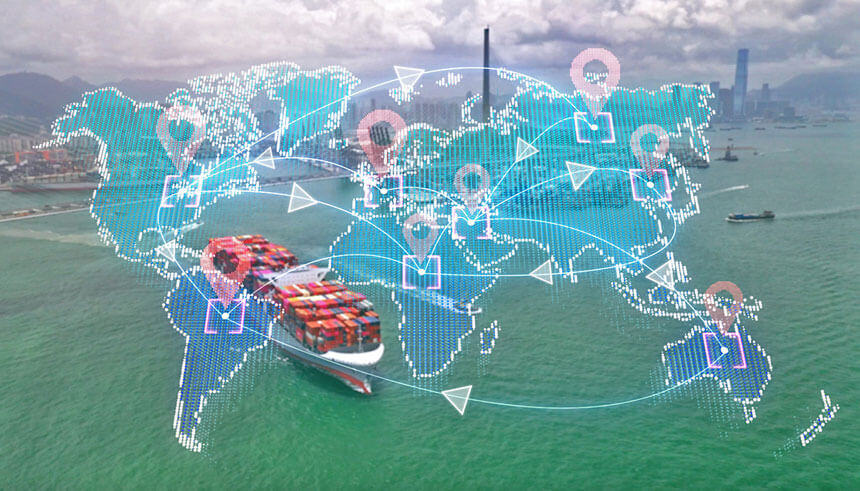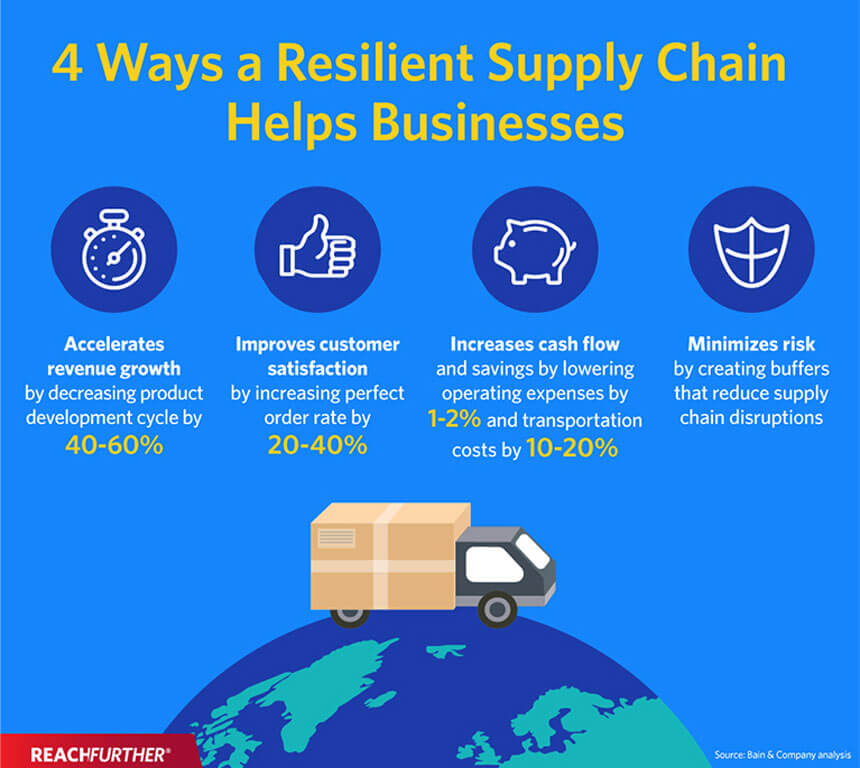![[CGCC E-Connects] Managing Supply Chain Disruptions During COVID-19 featured image](https://47510199.fs1.hubspotusercontent-na1.net/hub/47510199/hubfs/Imported_Blog_Media/Supply-Chain-1-1.jpg?width=800&name=Supply-Chain-1-1.jpg)
Article Source: East West Bank

As COVID-19 cases continue to
spread worldwide, businesses need to ensure that their supply chain is resilient.
(Photo credit): Gettyimages.com/MR.Cole_Photographer
How to prepare for short, medium and long-term disruptions caused by the novel coronavirus.
When the COVID-19 pandemic first spread through China,
businesses across all industries experienced—and are still
experiencing—disruptions to their supply chains due to government-mandated
shutdowns. China contributes 28 percent of global manufacturing
output, which makes it the world’s largest manufacturer and a hub that many
businesses rely on. Although some companies began shifting their suppliers to
other Asian countries like India and Vietnam, the global and uncertain nature
of the pandemic means that things are constantly in flux.
As COVID-19 cases continue to rise and spread worldwide
(currently, 213
countries and territories have reported coronavirus cases),
businesses need to ensure that their supply chain is resilient for the short,
medium and long term. Whether that’s diversifying manufacturers, or putting
together a task force, here is what you need to do to mitigate risks in your
supply chain.
Overview of supply chain disruptions
The COVID-19 outbreak has affected the supply chain in a number
of ways. Some regions like the United States have placed export
restrictions on medical goods and supplies to prevent domestic
shortages as they battle the coronavirus. Similarly, China has tightened import restrictions on
meat, dairy and other food products and now requires companies to certify that
their goods have not been contaminated by the disease.
Delays are also common, either due to government-mandated
shutdowns like the one China experienced, or because of reductions in
workforce, says Riza Buditomo, a partner at Indonesia-based Hadiputranto,
Hadinoto & Partners’ Tax & Trade Group.
“We are seeing that there are delays in supplying the product
due to the lack of manpower, because now the movement of people is quite a bit
restricted,” he explains.
Buditomo adds that factories have also been repurposed to
produce critical and in-demand goods like hand sanitizer and personal
protective equipment. Fluctuating consumer demand also contributes to the
disruptions to supply chains, since it’s difficult for businesses to know when
things will reopen, how quickly consumer confidence will return and what they
will be purchasing.

How a resilient supply chain
helps businesses
Reevaluate your contracts
When determining how to best fortify your supply chain, the
first thing you should do is to review in detail the terms and conditions in
all contracts with buyers and suppliers. Doing so will help you map out what
steps you can take if you’re dealing with a cash-strapped counterparty, or if
you yourself are financially stressed. You can also work with your
counterparties to vary your contract (meaning, you make amendments, supplement
or otherwise modify your existing contracts)—just remember to document those
new agreements.
“It’s very important to have a clear understanding about your
contractual entitlements and obligations,” says Kwun Yee Cheung, a partner at
the law firm Baker McKenzie. “Look at your options carefully: Is it an
exclusive agreement? If so, has an intervening event or a termination right
occurred? What are the notice requirements, should you wish to terminate?”
Events of default triggers are generally
broadly drafted in a contract, Cheung states. “Does that include a failure to
perform?” she says to ask. “There may also be
security default, so that’s the other side that you need to
be aware of, and are there obligations to mitigate?”
Cheung adds that it’s also important to consider any licenses
for tools and machinery. Are the licenses controlled by your supplier, or are
they in your control? “Be mindful that you yourself need to make sure that
you’re not acting in a way that is inconsistent with the contract terms, to
avoid being in breach of contract,” she warns. “It’s only with these options
and the legal positions clearly in your mind that you know where you stand, and
you’ll have a much better position to decide what to do from a commercial
perspective.”
Determine the necessity of the supplier
Once you have a clear idea of your legal position, you can move
on to determining what the next steps should be. Some questions to ask yourself
are: Is the supplier providing a product that is unique and can’t be easily
replaced? Looking at economics, is there a real need to look for alternatives
so that your business can maintain operations?
There are a variety of ways to tackle it, says Cheung, most of
which will be a combination of short, medium and long-term solutions.
“I think, to a certain extent, the answer will depend on the state of the relationship before the current COVID-19 disruptions,” believes Cheung. For instance, if you had a poor relationship with a supplier who does not provide a key product, you may want to look at alternatives. “Maybe [acquiring] the supplier is an option,” she suggests.
In the case that you have a good supplier and are dependent on
them, you’ll likely want to work through the disruptions together. “You might
want to assist them by making payments in advance, for example,” says Cheung.
“Or you might consider investing in the supplier by taking up a stake in its
operations.”
Short and long-term financing options
While many businesses might have prepared for some level of
business disruption, the extent and prolonged period of the COVID-19 shutdowns
have distressed many companies. If your business needs an influx of cash to maintain operations, Cheung
suggests a few considerations for the short and long term.
“Look at where spending can be reduced and take decisive action
quickly, because liquidity and cash to help you through the difficult spot will
be very, very important,” she emphasizes. External investors could also be
useful. For the short term, Cheung says to look into refinancing and, in the
long term, to seek out partners to join and invest in your business.
Cheung adds, “The final point I’d make is to keep an eye
on government stimulus packages… It may
be quite beneficial to tap into those resources during times of financial
stress.”
Consider diversifying your suppliers
Whether or not you have a good relationship with your
counterparty, it’s a good idea to diversify your suppliers for the future, so
that you aren’t overly reliant on just one company or region. If you decide to
look into alternatives, Buditomo has a few suggestions on what to consider
beforehand.
“If you're redirecting supply to a new market, then there are
other questions that you might want to ask—say, for example, is there any free
trade agreement that may be applicable for the new contract import? And if so,
what would be the applicable rules of origin, and can your goods meet the
requirement?” he says. “And if so, how long would it take to get the
certificate of origin issue, if possible at all, due to center restrictions are
locked down within the country?”
Keep open lines of communication
Considering that there is so much turmoil around the world, it’s
very important for businesses to remain in open communication with their
importers, exporters, suppliers and/or manufacturers. That way, businesses can
keep abreast of what is happening, not only with the businesses they have
contracted with, but regional events, as well.
“The buyers of the products or the people that have to provide
imports—they’re also going to be facing their own supply chain challenges,”
says Anne Petterd, a partner at Baker McKenzie. “So I think part of the
strategy for managing the COVID-19 supply chain is going to be seeking to vary
supply chain terms and engage with people.”
Along with setting up internal communications, Buditomo adds
that regularly communicating with “key supply chain participants” is also very
useful for getting early notice of important events, such as upcoming
regulations, restrictions or reopenings.
Petterd agrees and adds that frequent communication will help
with resuming regular operations. “We do need to keep connected as part of
being as best placed as possible to reestablish supply chains quickly,” she
says.
Put together a COVID-19 task force
Countries may have to undergo multiple lockdowns in order to fully contain
the coronavirus, which means that there likely will be continued government
mandates and restrictions that could affect supply chains at any given time.
“What I would suggest is for businesses to put together a team
to monitor changes,” says Ivy Tan, a tax and trade lawyer at Baker McKenzie.
“This is meant to be one step ahead of the restrictions, by monitoring a trend
so that they can come up with and execute plans quickly in a way that minimizes
compliance risk.”
Generally, it’s a good idea to be well-versed in the
restrictions imposed in each of your areas of operation, since local laws will
likely differ. Tan says that, as soon as restrictions are imposed or lifted,
the team should find out what businesses can and can’t do, and whether there
are any exemptions for certain businesses or industries, and if so, how to
obtain an exemption.
Buditomo adds that not only should you be monitoring your own
operations, but you should be examining the supply chain impact on others. He
uses the monitoring of government restrictions as an example: “If we focus our
attention to the rapid changing of the restrictions, as well as keep updated,
it would be useful for us to understand where the government is coming from,
and with what will be the government’s next action.”
For more tips, visit East West Bank’s business continuity
toolkit for the latest resources on how to deal with the pandemic.